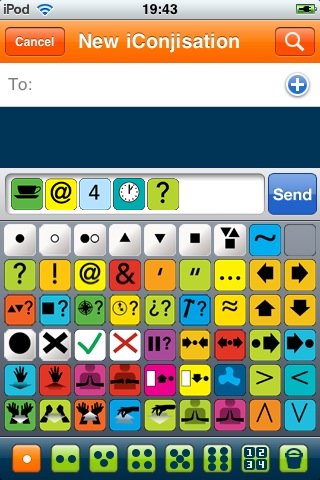
Electronic mail is a method of transmitting and receiving messages using electronic devices. It was conceived in the late–20th century as the digital version of, or counterpart to, mail. Email is a ubiquitous and very widely used communication medium; in current use, an email address is often treated as a basic and necessary part of many processes in business, commerce, government, education, entertainment, and other spheres of daily life in most countries.

A letter is a written message conveyed from one person to another through a medium. Something epistolary means that it is a form of letter writing. The term usually excludes written material intended to be read in its original form by large numbers of people, such as newspapers and placards, although even these may include material in the form of an "open letter". The typical form of a letter for many centuries, and the archetypal concept even today, is a sheet of paper that is sent to a correspondent through a postal system. A letter can be formal or informal, depending on its audience and purpose. Besides being a means of communication and a store of information, letter writing has played a role in the reproduction of writing as an art throughout history. Letters have been sent since antiquity and are mentioned in the Iliad. Historians Herodotus and Thucydides mention and use letters in their writings.
Punctuation marks are marks indicating how a piece of written text should be read and, consequently, understood. The oldest known examples of punctuation marks were found in the Mesha Stele from the 9th century BC, consisting of points between the words and horizontal strokes between sections. The alphabet-based writing began with no spaces, no capitalization, no vowels, and with only a few punctuation marks, as it was mostly aimed at recording business transactions. Only with the Greek playwrights did the ends of sentences begin to be marked to help actors know when to make a pause during performances. Punctuation includes space between words and the other, historically or currently used, signs.
The comma, is a punctuation mark that appears in several variants in different languages. It has the same shape as an apostrophe or single closing quotation mark in many typefaces, but it differs from them in being placed on the baseline of the text. Some typefaces render it as a small line, slightly curved or straight, but inclined from the vertical. Other fonts give it the appearance of a miniature filled-in figure 9 on the baseline.
The colon, :, is a punctuation mark consisting of two equally sized dots aligned vertically. A colon often precedes an explanation, a list, or a quoted sentence. It is also used between hours and minutes in time, between certain elements in medical journal citations, between chapter and verse in Bible citations, and, in the US, for salutations in business letters and other formal letter writing.
Programming style, also known as code style, is a set of rules or guidelines used when writing the source code for a computer program. It is often claimed that following a particular programming style will help programmers read and understand source code conforming to the style, and help to avoid introducing errors.
A paragraph is a self-contained unit of discourse in writing dealing with a particular point or idea. Though not required by the orthographic conventions of any language with a writing system, paragraphs are a conventional means of organizing extended segments of prose.
In computer programming, indentation style is a convention, a.k.a. style, governing the indentation of blocks of source code that is intended to result in code that conveys structure.
YAML(see § History and name) is a human-readable data serialization language. It is commonly used for configuration files and in applications where data is being stored or transmitted. YAML targets many of the same communications applications as Extensible Markup Language (XML) but has a minimal syntax that intentionally differs from Standard Generalized Markup Language (SGML). It uses Python-style indentation to indicate nesting and does not require quotes around most string values.
In the written form of many languages, indentation describes empty space, a.k.a. white space, used around text to signify an important aspect of the text such as:
Poste restante, also known as general delivery in North American English, is a service where the post office holds the mail until the recipient calls for it. It is a common destination for mail for people who are visiting a particular location and have no need, or no way, of having mail delivered directly to their place of residence at that time.
A lightweight markup language (LML), also termed a simple or humane markup language, is a markup language with simple, unobtrusive syntax. It is designed to be easy to write using any generic text editor and easy to read in its raw form. Lightweight markup languages are used in applications where it may be necessary to read the raw document as well as the final rendered output.

An address is a collection of information, presented in a mostly fixed format, used to give the location of a building, apartment, or other structure or a plot of land, generally using political boundaries and street names as references, along with other identifiers such as house or apartment numbers and organization name. Some addresses also contain special codes, such as a postal code, to make identification easier and aid in the routing of mail.
A salutation is a greeting used in a letter or other communication. Salutations can be formal or informal. The most common form of salutation in an English letter includes the recipient's given name or title. For each style of salutation there is an accompanying style of complimentary close, known as valediction. Examples of non-written salutations are bowing, waving, or even addressing somebody by their name. A salutation can be interpreted as a form of a signal in which the receiver of the salutation is being acknowledged, respected or thanked. Another simple but very common example of a salutation is a military salute. By saluting another rank, that person is signalling or showing his or her acknowledgement of the importance or significance of that person and his or her rank. Some greetings are considered vulgar, others "rude" and others "polite".

In a written or published work, an initial capital is a letter at the beginning of a word, a chapter, or a paragraph that is larger than the rest of the text. The word is derived from the Latin initialis, which means standing at the beginning. An initial is often several lines in height and in older books or manuscripts are known as "inhabited" initials. Certain important initials, such as the Beatus initial or "B" of Beatus vir... at the opening of Psalm 1 at the start of a vulgate Latin. These specific initials in an illuminated manuscript were also called initiums.
A valediction, or complimentary close in American English, is an expression used to say farewell, especially a word or phrase used to end a letter or message, or a speech made at a farewell.
In finance, a letter of transmittal is a type of cover letter that accompanies a document, such as a financial report or security certificate.

iConji is a free pictographic communication system based on an open, visual vocabulary of characters with built-in translations for most major languages.

Optical margin alignment outdents letters like A, V, W, Y, and punctuation into the margins to align the text border optically. Some users remark that it makes the text margin look crooked, but this is because text frames or margin guides are visible. If text frames are not visible, e.g. in print preview, or when printed, the edge of a block of text looks more even if optical margin alignment is enabled.

An ARRL radiogram is an instance of formal written message traffic routed by a network of amateur radio operators through traffic nets, called the National Traffic System (NTS).





